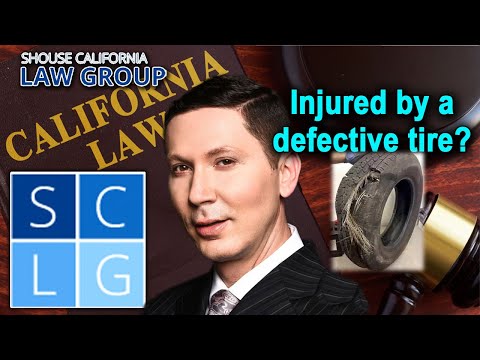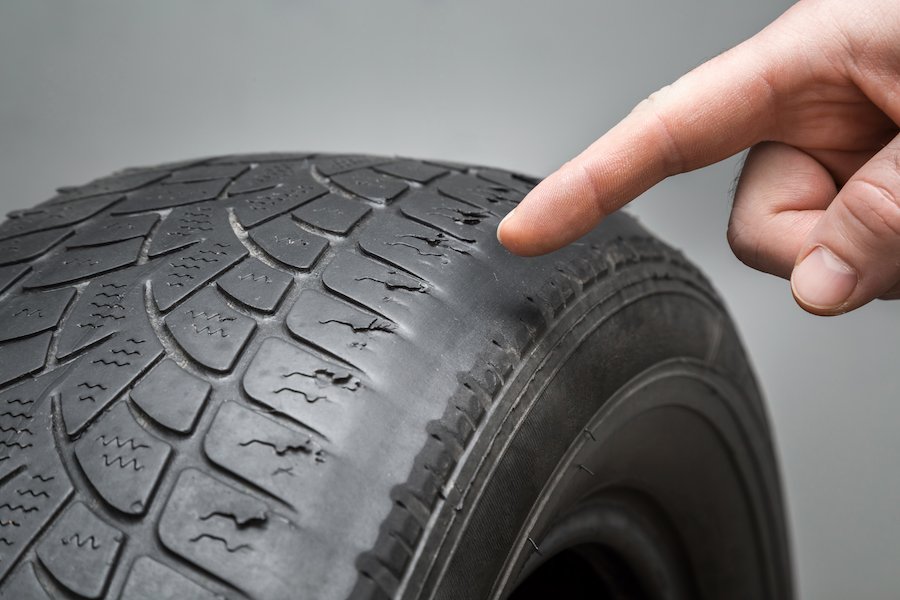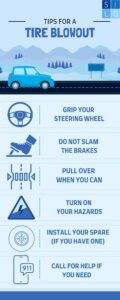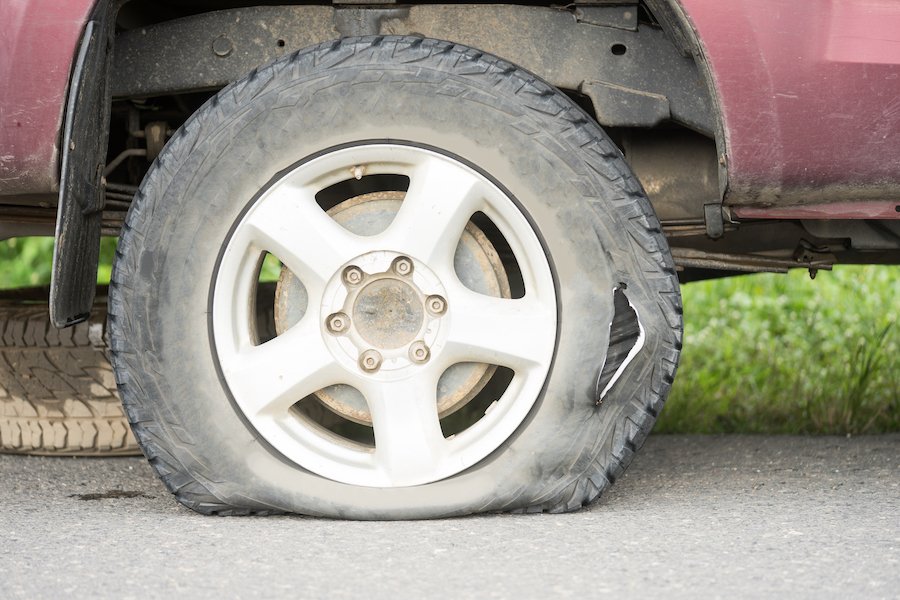
When a defective tire causes an accident, you may have a personal injury claim against the manufacturer of the tire, the distributor, and/or the seller of the tire.
You do not necessarily have to show who was responsible for the defect, only that the tire was defective and caused the accident. You can file a defective tire lawsuit for damages, including
- medical bills,
- lost wages, and
- pain and suffering.
Below, our California personal injury lawyers discuss the following frequently asked questions about lawsuits for accidents caused by defective tires:
- 1. Can I file a lawsuit if I was injured by a defective tire?
- 2. What damages are available?
- 3. How do defective tires cause accidents?
- 4. Who is to blame for a defective tire?
- 5. What if the tire was fine when I bought it?
- 6. What is strict liability for tire defects?
- 7. What are tire company defenses to a product liability lawsuit?
- 8. What if my spouse or partner was killed in an accident?
- 9. Tire defect cases and recalls
- Additional resources
If you have further questions about tire defect accidents after reading this article, we invite you to contact us at Shouse Law Group.
1. Can I file a lawsuit if I was injured by a defective tire?
If you are in a vehicle crash caused by tire failures, you may be able to file a lawsuit against the tire seller or manufacturer for damages.
If someone is killed in a car accident caused by a faulty tire, the family members may be able to file a wrongful death lawsuit in California for compensation and to hold the tire company responsible for their actions.
A traffic accident may also be caused by another driver who knew they were driving on a faulty tire. In this case, you may be able to file a personal injury lawsuit against the negligent driver for damages.
2. What damages are available?
In a defective tire case, you can seek damages for the losses associated with the accident. Compensatory damages in a personal injury lawsuit are intended to put you in a similar position you would have been but for the accident. These include:
- Lost wages,
- Medical and hospital bills,
- Pain and suffering,
- Car repairs,
- Lost earning potential, and
- Loss of consortium.

Faulty sidewall construction is a common tire defect.
3. How do defective tires cause accidents?
The tire on a vehicle is responsible for transferring the weight of the vehicle through the axle to the ground. The tire also provides traction and steering.
You rely on tires to control your vehicle at high speeds and avoid obstacles. When a tire is defective, it can cause you to lose control of the vehicle, resulting in an accident and injuring you and/or others.
The most common tire defects include
- tread separating from the tire and
- weak points in the tire causing a blowout.
Tread Separation
The tread is the part of the tire with patterns of grooves that allow the tire to grip the road. This includes grooves to allow water to be expelled and prevent hydroplaning on a wet surface.
If the tread begins to separate from the rest of the tire, also called delamination, you can lose control of your vehicle.
Tire tread separation can occur in new tires with design problems or manufacturing defects. Tread separation can also occur in tires that have been retreaded when there has not been enough curing time or inferior products were used to retread the tire. Improper flat tire repair can also cause tread separation.
Blowouts
Blowouts, or the tire rupturing while your car is traveling at speed, can be caused by design defects, manufacturing defects, or tread separation. The rubber can lose its bond with the internal steel belting and fabric reinforcement resulting in a rapid loss of air pressure.
Tire blowouts can also be caused by the vehicle owner’s negligence or operator error. Overloading a vehicle or using bad tires can cause a blowout and lead to an accident.
At high speed, a tire blowout can cause a driver to:
- lose control of the vehicle,
- veer off the road, or
- crash into a barrier or other vehicle.
4. Who is to blame for a defective tire?
Under California’s “product liability” laws, the party who designed, manufactured, or sold the defective workout product is strictly liable for injuries caused by that product.
To recover damages in a products liability case, you generally have to show:
- The defendant designed, manufactured, distributed or sold a defective product;
- The product contained the defect when it left the defendant’s possession;
- You used the product in a reasonably foreseeable manner; and
- You suffered an injury or harm as a result of the defect.1
To show your injuries were the result of the tire defect, you may have to present expert testimony showing the tire defect was a cause of the accident.
Your attorney will generally send the accident information and possibly the remaining pieces of the tire to a tire engineer or other expert. The expert will provide an opinion on how the tire defect may have caused your accident.
5. What if the tire was fine when I bought it?
If the tire was fine when it was sold to you, someone else may be liable for a tire-related accident. This could include a:
- Tire repair shop;
- Used tire seller;
- Mechanic; or
- Vehicle owner; or
- Vandal.
In these cases, you would sue the at-fault party for negligence. To prevail on a negligence claim, you need to prove:
- The defendant owed you a duty of care;
- The defendant breached that duty;
- The breach caused your injuries; and
- The injuries resulted in damages.2

6. What is strict liability for tire defects?
Strict liability in California product defect cases generally involves one of the following types of product defects:
6.1. Manufacturing defects
A manufacturing defect is something that occurs during production that causes a product to differ from:
- the manufacturer’s design or specifications, or
- other typical units of the same product line.4
In a tire defect case, evidence of a manufacturing defect could be shown by comparing the defective tire to other tires of the same product line or to the intended specifications. Any differences in the product could be evidence of a possible defect.
To prove liability for a tire manufacturing defect, you must prove the following four elements:
- The defendant manufactured, distributed or sold a tire;
- The tire contained a manufacturing defect when it left the defendant’s possession;
- You suffered an injury; and
- The tire’s defect was a substantial factor in causing your harm.5
6.2. Design defects
A tire defect may be considered a design defect if either:
- The tire failed to perform as safely as an ordinary consumer would expect when used in a reasonably foreseeable manner or as expected, or
- The benefits of the tire’s design do not outweigh the risk of danger inherent in such design.6
Based on the consumer expectation test, in order to recover damages in a defective tire design claim, you have to prove the following four elements:
- The defendant manufactured, distributed, or sold the tire;
- The tire did not perform as safely as an ordinary consumer would have expected when used as intended or in a reasonably foreseeable way;
- You were harmed; and
- The tire’s failure to perform safely was a substantial factor in causing your harm.7
In strict liability cases, you do not necessarily have to sue the company that was responsible for the defect. The defendant may be liable if the defendant “manufactured, distributed, or sold” the defective tire.
6.3. Warning defects
A tire could also be considered defective if the manufacturer, distributor, or seller did not provide adequate warnings or safety instructions for the tires. To recover damages on a failure to warn claim for defective tires, you must prove that:
- The defendant manufactured, distributed or sold the tire;
- The tire had potential risks that were known or knowable by the defendant;
- The risks presented a substantial danger when the product was used as intended or in a reasonably foreseeable way;
- Ordinary consumers would not have recognized the potential risks;
- The defendant failed to adequately warn consumers of the potential risks; and
- You were harmed as a result of the inadequate warnings.8
7. What are tire company defenses to a product liability lawsuit?
The tire company, distributor, or seller may claim a number of legal defenses to a claim of product liability. This is to avoid liability for the defective tire or to try and shift the blame onto someone else. Defenses to tire defect cases may include:
- The defendant did not manufacture, distribute, or sell the defective tires;
- The tire was not defective;
- The tire was misused or used in an unforeseeable way;
- You were not injured;
- Someone else modified or altered the tire after it was sold to you; or
- You caused the accident.
Even if the tire company is able to show you were partly to blame for the accident, you may still be able to recover partial damages from the tire company. Under California’s “comparative fault” law, you can recover damages based on the level of fault of the defendant.
For example, if the tire company is 80% at fault for selling a defective tire and you are 20% at fault for causing the accident, you may still be able to recover 80% of your damages from the tire company.
8. What if my spouse or partner was killed in an accident?
If you have lost a family member in a defective tire accident, you may be able to file a wrongful death lawsuit to hold the tire manufacturer responsible for their negligence.
Only certain family members are eligible to file a wrongful death lawsuit in California. This includes:
- A surviving spouse;
- A surviving domestic partner;
- Any children;
- Grandchildren (if the children are deceased); or
- Anyone else who would be entitled to the property of the decedent by California intestate succession laws.9
Damages in a wrongful death lawsuit include the losses suffered by you as a result of the death of your family member. This includes economic and non-economic compensatory damages such as:
- Burial expenses;
- Funeral costs;
- Loss of financial support to you that the deceased would have earned if they had survived; and
- Compensation for the loss of companionship, support, guidance, and affection.
9. Tire defect cases and recalls
There have been a number of reports of tire defects in the U.S. However, it generally takes multiple accidents and injuries before a tire company may initiate a recall or before the federal government requires the company to recall faulty tires.
There have been thousands of tire brands and lines reported for recalls, investigations, or complaints over the years. Every year, new complaints and recalls are issued for popular tire brands and sizes, including:
- Michelin
- Bridgestone
- Goodyear
- Pirelli
- Continental
- Hankook
- Firestone
- Kumho
- Kelly
Consumers can search for reports of recalls or complaints based on their tire brand and type at www.safercar.gov.

Tire defects is a common cause of loss of control by the driver.
Additional resources
Refer to these recent lawsuits involving defective tires:
- Pittsburgh Jury Returns $3.08 Million Tire Tread Defect Verdict Against Kumho Tire USA – Cision PR Newswire.
- Jury issues $11.7 million verdict in tire product liability case – Rubber News.
- Kumho hit with $3M verdict in Pa. truck rollover case – Tire Business.
- South Texas jury reaches $33 million verdict in case involving fatal crash, Goodyear tire – Caller Times.
Legal References:
- See California Civil Jury Instructions (CACI) Series 1200 — Products Liability.
- California Civil Jury Instructions (“CACI”) 400. See also California Civil Code section 1714(a) (“Everyone is responsible, not only for the result of his or her willful acts, but also for an injury occasioned to another by his or her want of ordinary care or skill in the management of his or her property or person.”)
- Soule v. GM Corp. (1994) 8 Cal.4th 548, 560 (“A manufacturer, distributor, or retailer is liable in tort if a defect in the manufacture or design of its product causes injury while the product is being used in a reasonably foreseeable way.”)
- California Civil Jury Instructions (CACI) 1202 — Strict Liability — “Manufacturing Defect” Explained.
- California Civil Jury Instructions (CACI) 1201 — Strict Liability — Manufacturing Defect Essential Factual Elements.
- Barker v. Lull Engineering Co. (1978) 20 Cal.3d 413.
- California Civil Jury Instructions (CACI) 1203 Strict Liability — Design Defect — Consumer Expectation Test.
- California Civil Jury Instructions (CACI) 1205 — Strict Liability — Failure to Warn – Essential Factual Elements.
- California Code of Civil Procedure 377.60 (“A cause of action for the death of a person caused by the wrongful act or neglect of another may be asserted by any of the following persons or by the decedent’s personal representative on their behalf: (a) The decedent’s surviving spouse, domestic partner, children, and issue of deceased children, or, if there is no surviving issue of the decedent, the persons, including the surviving spouse or domestic partner, who would be entitled to the property of the decedent by intestate succession.”)
- NHTSA Recalls. Campaign Number: 18T002000
- NHTSA Investigation: Goodyear G159 Tire
